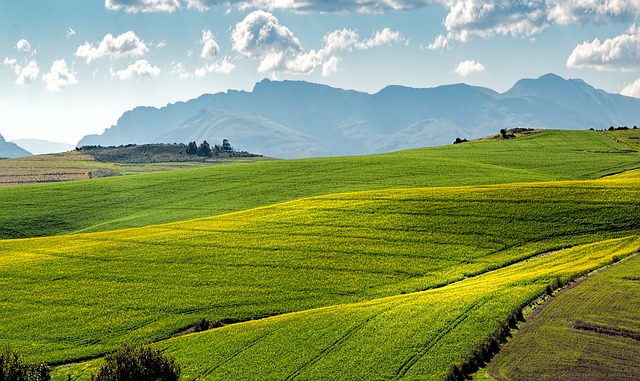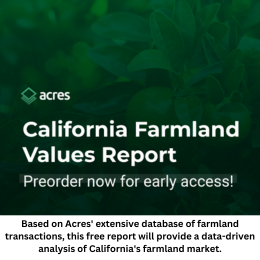April 23, 2020
By Lynda Kiernan
There are some developments in the farmland and ag investing space that I personally think of as “shorebird events”. This is a label I privately give to developments that, to me, create what I refer to as a ‘virtual infrastructure”. They act as a foundation, and create a framework. They override fragmentation and dissonance within a system to create order and provide solid ground, allowing us to see a horizon that is opportunity for growth.
The launch of Leading Harvest, (aptly on Earth Day) is what I would call a “shorebird event”. As we face unprecedented challenges in feeding a growing global population, while also trying to mitigate the negative environmental effects of doing so, sustainability has become foremost in the minds of agricultural producers, investors, and consumers.
But how do you know that your operation is sustainable? How do you know if the measures that are being taken are having the intended benefits? These are questions that not only have implications for the environment and the fight against climate change, but also have weight for impact investors striving to track and quantify improvements stemming from sustainability initiatives.
In recent years, the good intentions of farmers and others along the food supply chain have been faced with a complex landscape of sustainability platforms that use divergent data tools, metrics, and scales to attempt to measure factors associated with a single crop, issue, or stakeholder interest. This fragmentation has led to a lack of participation in key sustainability efforts, and has created a divide with consumer expectations.
Leading Harvest is a non-profit organization consisting of stakeholders across the agricultural value chain – companies that farm, own, and/or manage farmland, along with two environmental groups that together have created a new entity providing the first scalable, industry-wide universal sustainability standard that can be applied across all crops and geographies to address issues from climate change to biodiversity, and the resilience of cropland and communities.
“Consumers, investors and the supply chain have become increasingly interested in how their food is grown and sourced,” Oliver Williams, senior managing director, Global Head of Agricultural Investments HNRG, and chairman, Leading Harvest told GAI News. “At the root of this interest is a strong desire for a product that is grown to meet the needs of today without jeopardizing future generations’ ability to grow their food and meet their own needs. Yet current sustainability metrics vary widely across regions and operations.
“As the inaugural board chairman, I’m proud to be a part of an organization that both recognizes the hard work farmers do to practice sustainable agriculture and also brings greater transparency, adaptability and scalability to agricultural sustainability efforts.”
Development of this initiative has been in-process for two years by the 13-member Sustainable Agriculture Working Group (SAWG) including Peoples Company, AgIS Capital, Ceres Farms, Cottonwood Ag Management, Hancock Natural Resources Group, International Farming, Lamb Weston, Nuveen/Westchester, PGIM Agricultural Investments, The Rohatyn Group TRG, UBS Farmland Investors, The Conservation Fund, and Manomet, representing approximately 2 million acres of farmland across 22 states, and another 2 million acres in seven other countries.
Developed by growers and agricultural experts with deep experience in boots-on-the-ground farming, Leading Harvest takes a flexible, ground-up approach to eliminating the barriers to quantifiable, unified sustainability standards that sets the stage for widespread adoption across the agricultural ecosystem.
“At its heart, Leading Harvest’s Farmland Standard is solution-oriented – meaning it gives farmers the ability to innovate and advance sustainability practices in pursuit of outcomes,” said Williams. “This farmer-focused farmland standard can be applied to permanent crops, specialty crops and row crops alike, and across all regions and environments. To be in conformance with Leading Harvest’s standard, a producer aligns to best practices appropriate for their crop or region and demonstrates achieving outcomes in a continuous improvement framework.”
The platform addresses 14 key sustainability principles from soil heath, to water management, energy usage, air quality, conservation, and community interaction, as well as compliance with labor laws and regulations. And to ensure that the required outcomes are being met, Leading Harvest requires independent, third-party experts to audit producer performance across all categories of the standard.
“The independent, transparent auditing process provides assurance to consumers and the supply chain that producers are taking cutting-edge steps to increase sustainability and ensure the viability of our farmlands for generations to come,” said Matt Armstrong, sustainability advisor and lead auditor at K-Coe Isom.
Members of the SAWG have field-tested Leading Harvests’ standard on their own crops, including corn, soybeans, wine grapes, almonds, cranberries, pistachios, apples, walnuts, citrus, and peanuts, according to Carey Estes, with The Land Report, who notes that SWAG member, Hancock Natural Resources Group (HNRG), applied the standard to a range of its operations across California, Washington State, and Wisconsin. The results were then audited by third-parties to verify the findings and to determine areas for improvement.
“Hancock Natural Resource Group is committed to using the standard across its portfolio, which includes both row and permanent crops. Over time, our company plans to certify our acres under Leading Harvest by engaging third-party auditors,” said Williams.
This auditing will be a requirement for Leading Harvest participants, which will serve to gain the confidence of consumers, which now more than any time are educated and engaged in the origins of their food and how it is produced.
“This is a natural evolution of conservation in this country and for working farms,” Selzer told The Land Report. “It sets the tone for the next era, which is bringing together the environmental movement and the free-enterprise system. And where they converge on these working farms is really exciting and powerful. That is the way to view this new standard as it emerges in the marketplace. This is the next great leap forward for working farms and agriculture in this country. It will set agriculture on a positive trajectory for the foreseeable future.”
– Lynda Kiernan is Editor with GAI Media and daily contributor to the GAI News and Agtech Intel platforms. If you would like to submit a contribution for consideration, please contact Ms. Kiernan at lkiernan@globalaginvesting.

Let GAI News inform your engagement in the agriculture sector.
GAI News provides crucial and timely news and insight to help you stay ahead of critical agricultural trends through free delivery of two weekly newsletters, Ag Investing Weekly and AgTech Intel.




